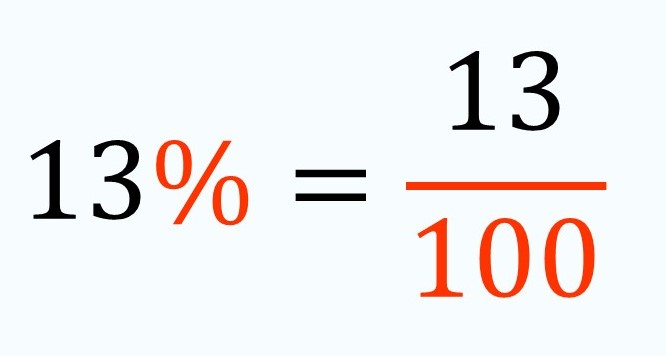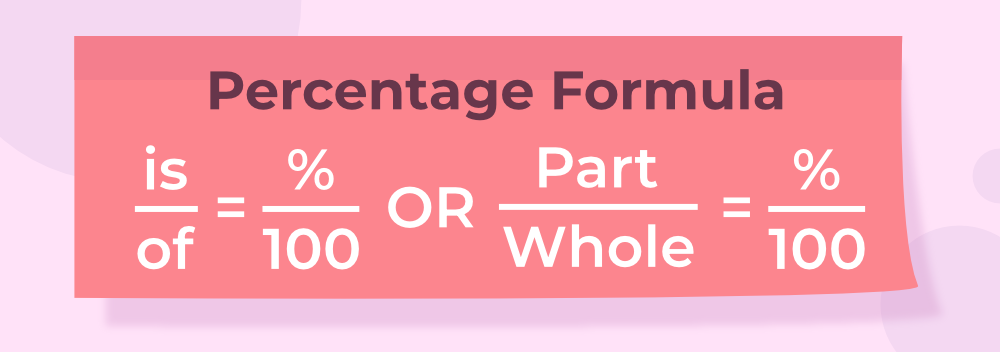Percentage plays a crucial role in various aspects of our lives, from calculating grades to analyzing financial data. Being able to calculate and understand percentages is a valuable skill that can be applied in both personal and professional contexts. In this article, we will explore the concept of percentage, learn how to calculate it, and delve into various examples to solidify our understanding.
What is Percentage?
Percentage is a representation of a number or ratio expressed as a fraction of 100. It is denoted by the symbol “%”. For example, if someone scores 80% on a test, it means they achieved 80 out of 100 possible points. Percentages are often used to compare quantities and determine the share of a whole.

Percentage Formula
To calculate the percentage of a number, we can use the following formula:
Percentage = (Part / Whole) × 100
In this formula, “Part” refers to the value we want to express as a percentage, and “Whole” represents the total value or quantity.

How to calculate the percentage of a number?
Calculating the percentage of a number involves a few simple steps. Let’s break it down:
- Determine the format of the initial number: The number can be in decimal or fraction form. If it’s a decimal, proceed to the next step. If it’s a fraction, convert it to a decimal by dividing the numerator by the denominator.
- Multiply the decimal number by 100: This step is necessary to convert the decimal into a percentage. Simply multiply the decimal by 100 to get the percentage value.
Let’s illustrate this process with an example. Suppose we want to find the percentage of 25 out of 50:
- Determine the format of the initial number: Both 25 and 50 are whole numbers, so we can proceed to the next step.
- Multiply the decimal number by 100: Since 25 is already in decimal form, we can skip this step.
Therefore, the percentage of 25 out of 50 is 50%.
Percentage Difference Formula
The percentage difference, also known as the percentage change, is used to compare the difference between two values in terms of percentage. The formula for calculating the percentage difference is:
Percentage Difference = (Absolute Difference / Average) × 100
In this formula, “Absolute Difference” refers to the absolute value of the difference between the two values, and “Average” represents the average of the two values.
Percentage Increase and Decrease
Percentage increase and decrease are used to measure the change in a value over a period of time. The formulas for calculating percentage increase and decrease are as follows:
Percentage Increase = ((New Value – Original Value) / Original Value) × 100
Percentage Decrease = ((Original Value – New Value) / Original Value) × 100
In these formulas, “New Value” represents the updated or increased value, and “Original Value” refers to the initial value.
Converting Fractions to Percentage
Converting fractions to percentages is a straightforward process. To convert a fraction to a percentage, follow these steps:
- Divide the numerator by the denominator to obtain the decimal equivalent of the fraction.
- Multiply the decimal by 100 to convert it into a percentage.
For example, if we have the fraction 3/4:
- Divide 3 by 4 to get 0.75.
- Multiply 0.75 by 100 to get 75%.
Therefore, 3/4 is equivalent to 75%.
Percentage Chart
Here is a percentage chart that shows the conversion of fractions to percentages:
| Fraction | Percentage |
|---|---|
| 1/2 | 50% |
| 1/4 | 25% |
| 1/5 | 20% |
| 1/10 | 10% |
| 3/4 | 75% |
| 2/5 | 40% |
| 3/5 | 60% |
| 4/5 | 80% |
This chart can be a helpful reference when converting fractions to percentages.
Conversion Between Percentages and Decimals
Converting between percentages and decimals is a simple process. To convert a percentage to a decimal, divide the percentage by 100. To convert a decimal to a percentage, multiply the decimal by 100.
For example, if we have the percentage 25%:
- To convert it to a decimal, divide 25 by 100. The result is 0.25.
- To convert the decimal 0.25 to a percentage, multiply it by 100. The result is 25%.
Difference Between Percentage and Percentile
While percentage and percentile are related concepts, they have distinct meanings. Percentage represents a part out of 100, whereas percentile refers to a specific ranking or position within a group.
For example, if someone scores in the 90th percentile on a test, it means they performed better than 90% of the population. On the other hand, if someone scores 90%, it means they achieved 90 out of 100 possible points.
Difference Between Percentage and Percent
The terms “percentage” and “percent” are often used interchangeably, but they have slightly different meanings. “Percentage” refers to a specific value or ratio expressed as a fraction out of 100. “Percent” is the symbol used to represent a percentage. So, while “percentage” is the concept itself, “percent” is the symbol used to denote it.
Percentage Tricks
There are a few tricks that can help simplify percentage calculations:
- To find 10% of a number, simply divide the number by 10.
- To find 5% of a number, divide the number by 20.
- To find 1% of a number, divide the number by 100.
These tricks can come in handy when calculating percentages mentally or estimating values quickly.
How to Calculate Percentage of Marks?
Calculating the percentage of marks is a common task in academics. It involves determining the proportion of marks obtained out of the total marks. To calculate the percentage of marks, follow these steps:
- Divide the marks obtained by the total marks.
- Multiply the result by 100 to obtain the percentage.
For example, if a student scored 80 out of 100 on a test:
- Divide 80 by 100 to get 0.8.
- Multiply 0.8 by 100 to get 80%.
Therefore, the student scored 80% on the test.
How to Calculate Percentage of Sales?
Percentage is often used in sales to calculate discounts, markups, and profit margins. To calculate the percentage of sales, use the following formula:
Percentage of Sales = (Part / Whole) × 100
In this formula, “Part” represents the value of the sales, and “Whole” refers to the total value or revenue.
For example, if a store made $5000 in sales and a particular item accounted for $1000 of those sales:
Percentage of Sales = (1000 / 5000) × 100 = 20%
Therefore, the item accounted for 20% of the store’s total sales.
Solved Examples on How To Find Percentage
Let’s work through a few examples to solidify our understanding of how to find percentages:
Example 1: Find 20% of 75.
Solution: To find 20% of 75, multiply 75 by 0.20 (the decimal equivalent of 20%). The result is 15.
Therefore, 20% of 75 is 15.
Example 2: A shirt that originally cost $50 is on sale for 25% off. What is the sale price?
Solution: To find the sale price, subtract 25% of $50 from $50.
25% of $50 is (25/100) * $50 = $12.50.
Subtracting $12.50 from $50 gives us a sale price of $37.50.
Therefore, the sale price of the shirt is $37.50.
Example 3: The population of a city increased from 500,000 to 600,000 in ten years. What is the percentage increase?
Solution: To find the percentage increase, subtract the original population from the new population, divide the result by the original population, and multiply by 100.
Percentage Increase = ((600,000 – 500,000) / 500,000) × 100 = (100,000 / 500,000) × 100 = 20%
Therefore, the population of the city increased by 20%.
How Kunduz Can Help You Learn How To Find Percentage?
At Kunduz, we understand the importance of mastering mathematical concepts like percentages. That’s why we offer comprehensive online math classes for students of all grade levels. Our expert tutors provide personalized instruction and guide students through various mathematical topics, including percentages. With Kunduz, you can gain a deep understanding of percentage calculations and develop the skills needed to excel in math. Sign up for our live online classes today and discover the power of personalized math education.
Other Math Topics:
